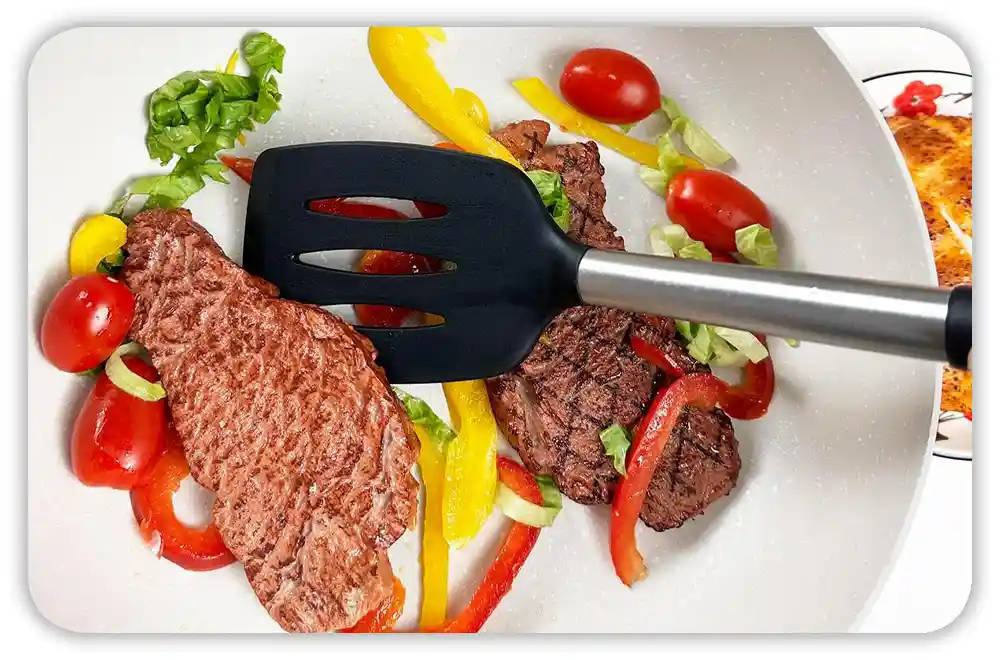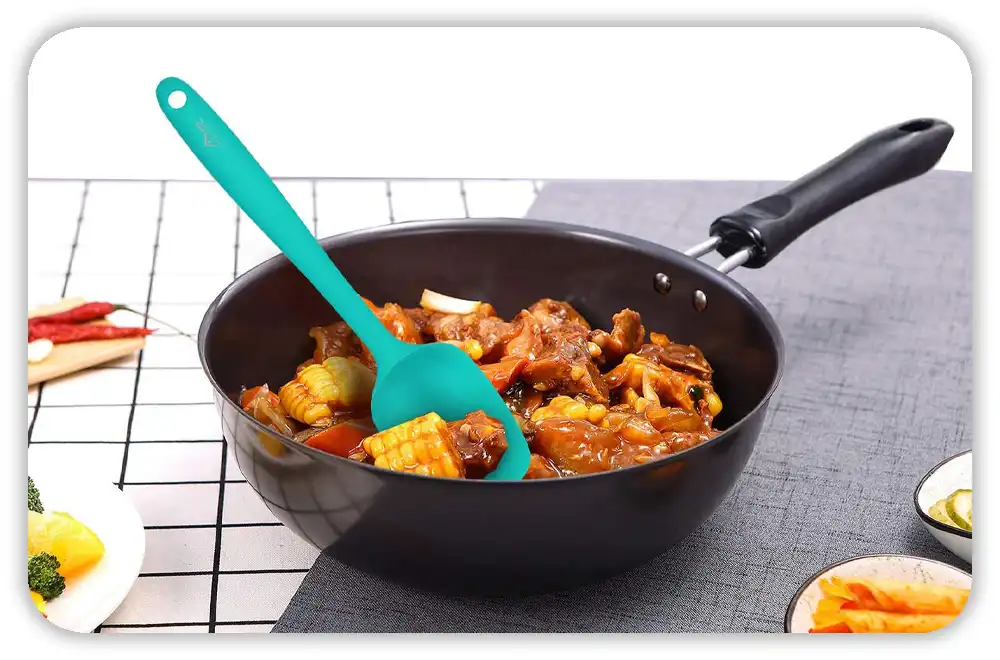Have you ever wondered if you really need both a spatula and a rubber scraper? I used to think they were the same. But after years of cooking and baking, I’ve learned how different they are—and why both are so useful. I grab the spatula for flipping pancakes. I reach for the scraper to get every last drop of batter from the bowl.
In this review, I’ll show you how they compare, explain what makes each tool special, and help you choose the one that fits your kitchen needs best. Let’s jump in and settle the spatula vs rubber scraper debate!
Table of Contents
Spatula Review
A spatula is one of the most helpful tools in the kitchen. You can flip pancakes, spread frosting, or scrape batter from a bowl with it. It’s hard to imagine cooking without one! But with so many options, finding the right spatula can feel tricky. Let me break it down for you.

What I Like
- Different Materials: Spatulas come in silicone, metal, plastic, and wood. Silicone is heat-safe, so it’s great for hot pans. Plastic works well for non-stick pans.
- Durable: Good spatulas last for years. Silicone ones don’t melt, crack, or absorb smells. They can handle daily use like a pro.
- Easy to Clean: Many spatulas are dishwasher-safe, especially silicone or plastic ones. This saves time after cooking.
- Versatile: Spatulas do more than flip food. They’re great for mixing, spreading, and scraping. They’re like the kitchen’s multitool.
What Could Be Better
- Plastic Problems: Plastic spatulas can melt in high heat. Over time, they may crack or pick up smells from strong foods.
- Limited Sizes: Some brands don’t offer many size options. A big spatula is great for pancakes but not for small bowls.
- Uncomfy Handles: Some spatula handles are hard to hold. This can make cooking less fun, especially for long tasks.
My Personal Cooking Experience
Once, I left a plastic spatula near a hot pan. It melted and made a mess. That’s when I switched to silicone for stovetop cooking. Silicone spatulas are lifesavers!
My favorite spatula is silicone with a steel core. It’s strong enough for thick dough and soft enough for scraping bowls. It’s the perfect balance.
When I bake, my flexible silicone spatula helps me get every bit of batter. It also spreads frosting like a dream. I can’t imagine baking without it.
Recommendation
Who It’s For:
- Home cooks who want a tool for baking and cooking.
- People with non-stick cookware—silicone or plastic is best to avoid scratches.
- Bakers who want a flexible spatula for scraping or spreading.
Who Might Look Elsewhere:
- High-heat cooks—skip plastic. Choose silicone or metal instead.
- Those who like style—wooden spatulas look nice but need extra care.
Tips for Choosing:
- Use silicone or plastic spatulas on non-stick pans.
- If you’re unsure, buy a set with different types. That way, you’ll have options for every job.
A spatula is more than just a tool—it’s your kitchen buddy. With the right one, cooking feels easier and more fun. Whether you’re flipping, mixing, or spreading, there’s a perfect spatula waiting for you. Happy cooking!
👉🏻👉🏿 Check Latest Price and Offer at Amazon 👈🏿👈🏻
Rubber Scraper Review
Rubber scrapers are a must-have tool in any kitchen. They’re perfect for mixing, folding, or scraping ingredients. Modern designs are more durable and heat-resistant than older versions. These simple tools are reliable, but they do have some downsides too.

What I Like
- Versatile Tasks: Rubber scrapers are great for scraping bowls, folding whipped cream, or mixing batters. They’re flexible and work for most kitchen jobs.
- Handles Heat: Silicone scrapers can handle high heat. I use mine for stirring hot sauces or cooking on the stove without worry.
- Long-Lasting: Many scrapers now use silicone, which doesn’t crack or warp like older rubber. They stay in great shape even after years of use.
- Easy to Grip: Most scrapers now have ergonomic handles. This makes them comfortable to hold, even when you’re stirring for a long time.
- Simple Cleaning: Silicone scrapers don’t stain or hold odors. Most are dishwasher-safe, so cleanup is quick and easy.
What Could Be Better
- Not for Heavy Mixing: Scrapers can bend when used with thick doughs or heavy tasks. A wooden spoon works better for these.
- Weak Handles: Some cheaper scrapers have handles that detach over time, which can be annoying.
- Pricey Options: Silicone scrapers cost more than standard rubber ones. Occasional bakers might not find them worth it.
- Not Precise Enough: For tasks like frosting cakes or detailed work, scrapers can feel bulky. A spatula is better for those jobs.
My Personal Baking Experience
I’ve been using silicone scrapers for years. My favorite can handle heat up to 500°F. It’s my go-to for folding delicate macaron batter. It’s also amazing for scraping cookie dough out of the bowl—no mess, no waste!
One time, I bought a cheap scraper, and it broke while I was stirring pancake batter. Since then, I only buy high-quality silicone ones. They last longer and work better for everything from mixing brownies to stirring hot sauces.
I also love how they work for cooking. My scraper is perfect for stirring béchamel sauce. It doesn’t melt or warp, and it gets every bit off the sides of the pan.
Recommendation
Great For:
Rubber scrapers are ideal for bakers, home cooks, or anyone who loves simple tools. They work well for mixing, folding, or cooking sauces.
Consider Other Tools If:
For heavy doughs or detailed frosting, pick something stronger, like a wooden spoon or angled spatula.
Tips for Choosing the Right Scraper:
- Pick silicone for durability and heat resistance.
- Look for seamless designs to avoid bacteria build-up.
- Choose a comfortable handle for easier use.
Rubber scrapers might not seem exciting, but they’re a kitchen hero. They make baking and cooking easier, cleaner, and more fun. Invest in a good one, and you’ll wonder how you ever managed without it!
👉🏻👉🏿 Check Latest Price and Offer at Amazon 👈🏿👈🏻
Spatula vs Rubber Scraper: Key Comparison
Spatulas and rubber scrapers are must-have kitchen tools. Choosing the right one saves time and effort. This review looks at how they perform, how easy they are to use, and their value.
Flexibility: Spatula vs Rubber Scraper
Flexibility matters for different tasks like cooking and baking.
| Feature | Spatula | Rubber Scraper |
| Cooking Tasks | Stiff for flipping and stirring. | Flexible for scraping bowls. |
| Baking Tasks | Good for light mixing. | Perfect for folding and mixing. |
| Material Flexibility | Moderate, varies by material. | High due to soft silicone. |
Winner: Rubber scraper for its flexibility, especially in baking.
Durability: Spatula vs Rubber Scraper
Durability shows how long tools last with regular use.
| Feature | Spatula | Rubber Scraper |
| Material Strength | Silicone or metal lasts longer. | Softer materials wear out faster. |
| Heat Resistance | Handles higher heat well. | May warp with high heat. |
| Maintenance | Easy to clean and store. | Needs careful cleaning. |
Winner: Spatula for its strength and heat resistance.
Grip Comfort: Spatula vs Rubber Scraper
Comfort is key for long kitchen tasks.
| Feature | Spatula | Rubber Scraper |
| Grip Design | Ergonomic handle for control. | Lightweight and simple to hold. |
| Weight | Balanced for stirring tasks. | Light for precise work. |
| Fatigue Level | Low for extended use. | Minimal for short tasks. |
Winner: Rubber scraper for being light and easy to handle.
👉🏻👉🏿 Check Latest Price and Offer at Amazon 👈🏿👈🏻
Performance: Spatula vs Rubber Scraper
Performance measures how well these tools work in the kitchen.
| Feature | Spatula | Rubber Scraper |
| Cooking Efficiency | Best for flipping and spreading. | Great for scraping and folding. |
| Baking Versatility | Works but has limits. | Perfect for precise mixing. |
| Durability in Use | Strong and lasts long. | Ideal for delicate tasks only. |
Winner: Spatula for better performance in a variety of tasks.
Ease of Use: Spatula vs Rubber Scraper
Ease of use depends on design and handling.
| Feature | Spatula | Rubber Scraper |
| Learning Curve | Easy to use. | Very simple for anyone. |
| Weight and Balance | Balanced and sturdy. | Light and effortless. |
| Cleaning | Dishwasher-safe and simple. | Edges may take extra care. |
Winner: Rubber scraper for its simplicity and beginner-friendly use.
Value for Money: Spatula vs Rubber Scraper
Value depends on price and quality.
| Feature | Spatula | Rubber Scraper |
| Price Range | $8–$20 for quality models. | $7–$15 for top brands. |
| Durability | Built to last for years. | May need frequent replacing. |
| Versatility | Useful for many tasks. | Best for scraping and mixing. |
Winner: Spatula for long-term value and versatility.
Read More: Nylon vs Silicone Spatula
Overall: Spatula vs Rubber Scraper
| Feature | Spatula | Rubber Scraper |
| Strengths | Durable and heat-resistant. | Flexible and precise. |
| Weaknesses | Not ideal for delicate tasks. | Less durable with heat. |
| Best Use | Great for cooking tasks. | Best for baking and scraping. |
Winner: Spatula for its versatility and strength.
👉🏻👉🏿 Check Latest Price and Offer at Amazon 👈🏿👈🏻
Recommendation
- Who Should Buy a Spatula? Perfect for cooking and everyday tasks.
- Who Should Buy a Rubber Scraper? Ideal for bakers who need precision.
Both tools are helpful, but together they make any kitchen ready for all tasks.
FAQs: Spatula vs Rubber Scraper
Can you use a rubber scraper as a spatula?
You can use a rubber scraper for light flipping or spreading, but it’s not as stiff as a spatula. It’s better for mixing or scraping than heavy tasks.
Are spatulas better for cooking, or should I use a rubber scraper?
Spatulas are best for stovetop cooking because they handle heat well. Rubber scrapers are great for mixing, scraping bowls, and delicate tasks.
What materials are best for spatulas and rubber scrapers?
Silicone is the best choice. It’s flexible, durable, and heat-resistant. Wood or plastic tools can warp or melt under high heat.
Which is better for nonstick cookware: spatula or rubber scraper?
Both are safe for nonstick cookware if made from silicone. Avoid metal tools, as they can scratch and damage the surface.



